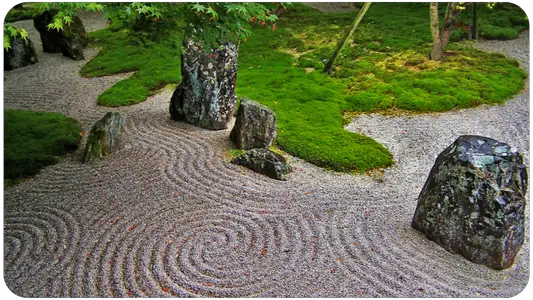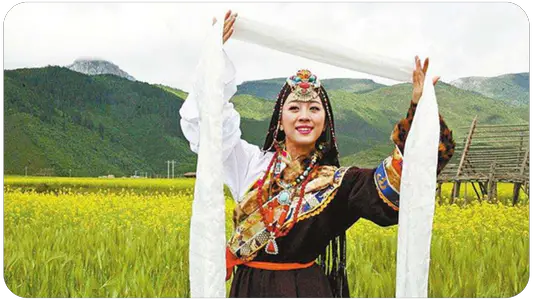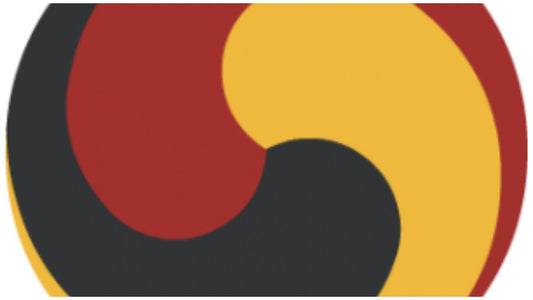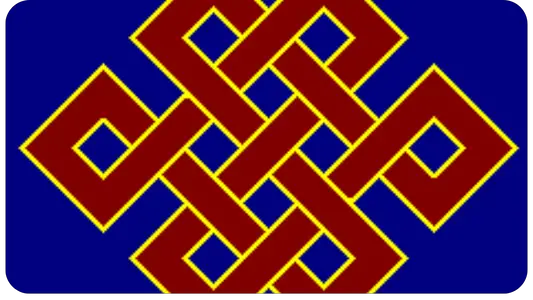Shamarpa (also Rothut Lama or later Rothut Karmapa; often erroneously Sharmapa) is an important Trülku lineage of the Karma Kagyu school of Tibetan Buddhism. The Shamarpa is also considered to be the emanation of Amitabha.
His incarnational lineage is closely related to that of the Gyelwa Karmapa, the head of the Karma Kagyu.
Very little is known about the 11th, 12th and 13th Shamarpa, since his rebirth at the time of the 11th Shamarpa was forbidden by the government of Tibet for reasons of power politics, and therefore these three incarnations could not be officially recognized.
Only the last 14th Shamarpa Künsig Shamar Mipham Chökyi Lodrö (1952-2014), the second highest lama of the Karma Kagyu, became again a significant figure in the history of the Karma Kagyu after the enthronement of Thaye Dorje as the 17th Gyalwa Karmapa.
He was born in Dêgê (Garzê, Sichuan) and at the age of four was taken to Tshurphu Monastery (Tibet), where he was recognized by the 16th Karmapa as the 14th Shamarpa.
Red Hat Karmapa
The name Rothut-Karmapa comes from historical texts of Gölo Shönnu Pel (1392-1481), the 2nd Pawo Rinpoche Tsuglag Trengwa (1504-1566), the 5th Dalai Lama (1617-1682) and the 8th Tai Situpa, Chökyi Chungne (1700-1774), in which the respective Shamarpa is called so.
History of the Shamarpas
13th century
The 1st Shamarpa Khedrub Dragpa Sengge (1283-1349) was one of the most important disciples of the 3rd Karmapa (1284-1339), who confirmed him as another emanation of the 2nd Karmapa Karma Pakshi, who had predicted that he would manifest in two Nirmanakaya forms, in addition to Karmapa himself.
The 3rd Karmapa now presented the 1st Shamarpa with a ruby red hat, which was the exact image of his own black hat. This was to be a symbol of the inseparability of the minds of the Karmapas and the Shamarpas.
The name Shamarpa "the one with the red hat" (or the red crown) comes from this time. It also fulfilled a prophecy of Shakyamuni in the Kalpa Sutra, according to which a great bodhisattva with a red hat (or crown) was to come to liberate sentient beings from samsara.
17th century
The Karma Kagyu lineage unfolded over 500 years and was one of the most influential schools of Tibetan Buddhism in the early 17th century, at the time of the 10th Karmapa (1604-1674).
The death of the popular 6th Shamarpa Mipham Chökyi Wangchug (1584-1630), who was held in high esteem by the most powerful Gelugpa lama at the time, the 5th Dalai Lama, weakened the political position of the Karma Kagyu lineage.
A long-simmering political conflict between the Karma Kagyu and the Gelugpas escalated. The 10th Karmapa, who left the regency of his monasteries to the 5th Goshri Gyeltshab Rinpoche Dragpa Chöyang (1618-1658), and the 7th Shamarpa Yeshe Nyingpo (1631-1694) and their followers were attacked but managed to escape.
When the Mongol prince Gushri Khan finally invaded with an army the kingdom of Tsang, whose king was a follower of the 10th Karmapa, and a year later installed the 5th Dalai Lama Lobsang Gyatsho as sovereign of all Tibet, the Karma Kagyu school lost all political influence in Tibet.
The victorious Gelug consolidated their political power by suppressing the Karma Kagyu lineage in the politically important central provinces, mainly Tsang. In addition to 27 monasteries of the Karmapa, 20 monasteries of the Shamarpa were also forcibly converted to the Gelugpa school.
Only Tsurphu, the seat of the Karmapa, and Yangpachen, the main monastery of the Shamarpa, and a few others were allowed to continue practicing the Karma Kagyu tradition.
18th century
In the early 18th century, the 7th Goshri Gyeltshab Könchog Öser (1699-1765), the 8th Tai Situpa Chökyi Chungne (1700-1774), the 8th Shamarpa Pelchen Chökyi Döndrub (1695-1732), and the 12th Karmapa (1703-1732) made a pilgrimage to India and Nepal.
In Nepal they were highly honored by the king of that time and in India they visited the holy places of Buddha Shakyamuni. The 12th Karmapa and the 8th Shamarpa had such an outstanding reputation during the reign of the Chinese Emperor Yongzheng that they were invited to his court in 1732.
Both died of smallpox the day after their arrival in Beijing. The two Gelugpa Lamas Kyangkya and Thudka claim in their autobiographies that the death of the two highest Kagyu Lamas was a result of black magic. After the death of the 12th Karmapa and the 8th Shamarpa, the Karma Kagyu lineage suffered a renewed period of decline in central Tibet.
During the reign of the Chinese Emperor Qianlong in the 18th century, the powerful 6th Penchen Lama Lobsang Pelden Yeshe, i.e. the second most powerful lama of the Gelug school, and the 10th Shamarpa Mipham Chödrub Gyatsho (1742-1792), recognized by the 13th Karmapa, were brothers.
The 10th Shamarpa hoped that his kinship with the Penchen Lama might persuade the Tibetan government to restore his monasteries, forcibly converted by the Gelugpas in the previous century, to their former state. Before this could happen, however, the Panchen Lama died of smallpox in Beijing, where he had been invited by the emperor.
Out of deep respect for the Penchen Lama, who had been his teacher, the emperor is said to have given a large amount of gold coins to the Penchen Lama's brothers and sisters, including the Shamarpa.
However, Trashi Lhünpo Monastery, the seat of the Penchen Lama, is said not to have given the 10th Shamarpa his due. When the administration of Yangpachen Shamarpa Monastery complained about this, it was said that all the gold belonged to Trashi Lhünpo Monastery.
The 10th Shamarpa was called a traitor for inciting a rebellion against the Tibetan government to get his monasteries back. As a result, hostility arose against the Shamarpa in the Tibetan government, which was led by two regents in the absence of the 8th Dalai Lama. Because of this, he fled Tibet for the safety of neighboring Nepal in 1784.
Since the Nepalese king, Rana Bahadur Shah, believed he could derive political benefit from Shamarpa's presence, Shamarpa became involved in an economic-political conflict between Nepal and Tibet that eventually escalated militarily.
The negotiations in which Shamarpa participated failed and the Tibetan delegation that had come to Nepal was captured. In addition, King Bahadur sent troops into Tibet, but they were repelled with the help of Chinese troops, and peace was reached between Nepal and Tibet in 1792.
However, the Tibetan government blamed the 10th Shamarpa for the political and military debacle. In retaliation, it confiscated Yangpachen Monastery, which was converted to the Gelugpa school. Most importantly, she issued a "ban on the institution of Shamarpa's rebirths." In 1792, the 10th Shamarpa died of jaundice, but rumors circulated that he had poisoned himself.
20th/21st century
In 1956, the 16th Karmapa invited the current Dalai Lama Tendzin Gyatsho to Tshurphu Monastery and asked him to lift the ban on the Shamarpas. The Dalai Lama agreed, but advised Karmapa to first perform the initial enthronement ceremony for the 14th Shamarpa at Tshurphu so that the Tibetan government could then publicly announce the lifting of the ban.
The enthronement was held at Tshurphu Monastery in 1957, but before the government could announce the lifting of the ban, the Dalai Lama, Karmapa and Shamarpa had to flee Tibet for India in 1959 to escape the Chinese Communist invasion.
Although Tibet was lost, Karmapa again asked the Dalai Lama to lift the ban against the Shamarpas. In 1963, the Dalai Lama granted this request with a letter to that effect.
The following year, the official main enthronement of the 14th Shamarpa took place at Rumtek Monastery in Sikkim, in the presence of delegates from the four main schools of Tibetan Buddhism and the Indian and Sikkimese governments.
Until 1979, he received all the teachings and transmissions of the Karma Kagyu lineage from the 16th Karmapa at Rumtek Monastery in Sikkim. He then traveled the world teaching Buddhism in the transmission of the Karma Kagyu tradition.
He focused especially on the Mahayana teachings, the Madhyamaka, that is, the teachings of the "middle way." Shamarpa founded the international Buddhist organization "Bodhi Path". In this organization the teachings of the Karma Kagyu school are transmitted in their traditional form.
But he also teaches in the centers of the Diamond Path of Lama Ole Nydahl. It was mainly due to Shamarpa's activity that Thaye Dorje left Tibet in 1994 and now lives in the Karmapa International Buddhist Institute in New Delhi .





